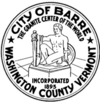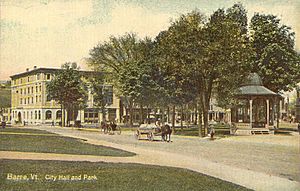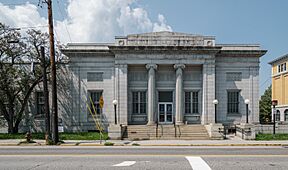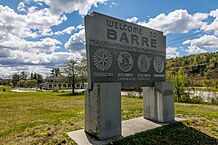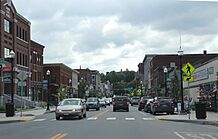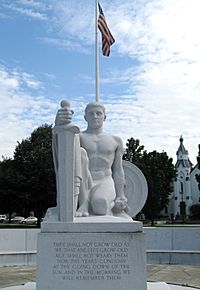Barre (city), Vermont facts for kids
Quick facts for kids
Barre, Vermont
|
|||
|---|---|---|---|
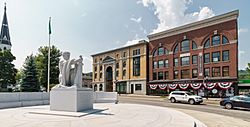
"Youth Triumphant" welcomes visitors to Barre
|
|||
|
|||
| Nickname(s):
Granite Center of the World
|
|||
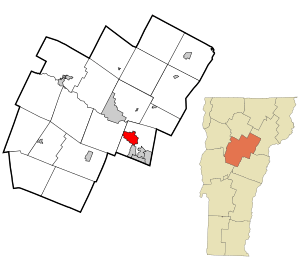
Location in Washington County and the state of Vermont.
|
|||
| Country | United States | ||
| State | |||
| County | Washington | ||
| Incorporated | 1895 | ||
| Named for | Isaac Barré | ||
| Area | |||
| • City | 3.98 sq mi (10.31 km2) | ||
| • Land | 3.95 sq mi (10.22 km2) | ||
| • Water | 0.03 sq mi (0.08 km2) | ||
| Elevation | 609 ft (186 m) | ||
| Population
(2020)
|
|||
| • City | 8,491 | ||
| • Density | 2,160.63/sq mi (834.29/km2) | ||
| • Metro | 59,626 | ||
| Time zone | UTC−5 (Eastern (EST)) | ||
| • Summer (DST) | UTC−4 (EDT) | ||
| ZIP code |
05641
|
||
| Area code(s) | 802 | ||
| FIPS code | 50-03175 | ||
| GNIS feature ID | 1462035 | ||
Barre (/ˈbæri/ BARR-ee) is a city in Washington County, Vermont, United States. It is the most populated city in the county. In 2020, about 8,491 people lived there. People often call it "Barre City" because it's almost completely surrounded by "Barre Town," which is a separate area.
Barre is often mentioned with Montpelier, the state capital, in local news and businesses. It's the main city in the Barre-Montpelier area, which has almost 60,000 residents. This makes it Vermont's third-largest metropolitan area. Barre is also the fifth largest city in Vermont.
Contents
Exploring Barre's Past
How Barre Began
On November 6, 1780, a large piece of land was given to William Williams and 64 other people. This land was first called Wildersburgh. It included both what is now Barre City and Barre Town. The first settlers arrived in 1788. They were John Goldsbury and Samuel Rodgers, with their families.
People living there didn't like the name Wildersburgh. So, they decided to rename the town after Isaac Barré. He was a supporter of the American Colonies. In 1895, about 4 square miles (10.31 km2) of the town became a separate city.
Barre's Famous Granite Industry
Barre is known as the "Granite Center of the World." The granite industry started after the War of 1812. This was when huge amounts of granite were found at Millstone Hill. The city and its granite business grew a lot when the railroad arrived.
The granite deposit is very famous. Geologists say it's about 4 miles (6.4 km) long, 2 miles (3.2 km) wide, and 10 miles (16 km) deep. News of this amazing granite spread to Europe and Canada. Many people moved to Barre from countries like Italy, Scotland, Spain, Scandinavia, Greece, and Lebanon. The population grew quickly, from 2,060 in 1880 to 10,000 in 1894. By the early 1900s, Barre was known as Vermont's most diverse city.
Today, Millstone Hill has a network of wooded trails. You can still see old mining holes and piles of rock there.
The Italian immigrants brought new ideas about workers' rights to Barre. In the 1920s and 1930s, there were several granite strikes. Workers wanted better pay and safer conditions in the quarries and workshops. The Quarry Workers' International Union of North America was based in Barre. The city even elected a Socialist Party mayor in 1916 and 1929. The old Socialist Labor Party Hall is still standing and is a historic site.
"Barre Gray" granite is famous worldwide. It's known for its fine look and how well it lasts in all kinds of weather. Many artists choose it for outdoor sculptures. Hope Cemetery in Barre shows off many beautiful granite sculptures made by artists.
Barre's Location and Weather
Barre covers about 4 square miles (10.31 km2) of land. The Stevens Branch River and the Jail Branch River flow through the city. These rivers are branches of the Winooski River.
Major roads like I-89 and US 302 serve the city. Barre is next to the town of Berlin on its west side. Otherwise, it's surrounded by the separate Town of Barre.
| Month | Jan | Feb | Mar | Apr | May | Jun | Jul | Aug | Sep | Oct | Nov | Dec | Year |
|---|---|---|---|---|---|---|---|---|---|---|---|---|---|
| Record high °F (°C) | 66 (19) |
70 (21) |
82 (28) |
90 (32) |
91 (33) |
95 (35) |
97 (36) |
97 (36) |
92 (33) |
84 (29) |
76 (24) |
67 (19) |
97 (36) |
| Mean maximum °F (°C) | 50 (10) |
50 (10) |
60 (16) |
76 (24) |
84 (29) |
88 (31) |
88 (31) |
87 (31) |
84 (29) |
75 (24) |
65 (18) |
52 (11) |
90 (32) |
| Mean daily maximum °F (°C) | 25.8 (−3.4) |
28.9 (−1.7) |
37.6 (3.1) |
51.5 (10.8) |
65.0 (18.3) |
73.2 (22.9) |
77.6 (25.3) |
76.1 (24.5) |
68.6 (20.3) |
55.3 (12.9) |
42.8 (6.0) |
31.3 (−0.4) |
52.8 (11.6) |
| Daily mean °F (°C) | 16.6 (−8.6) |
18.9 (−7.3) |
27.9 (−2.3) |
40.9 (4.9) |
53.3 (11.8) |
61.8 (16.6) |
66.5 (19.2) |
64.9 (18.3) |
57.4 (14.1) |
45.5 (7.5) |
34.4 (1.3) |
23.2 (−4.9) |
42.6 (5.9) |
| Mean daily minimum °F (°C) | 7.4 (−13.7) |
8.9 (−12.8) |
18.1 (−7.7) |
30.3 (−0.9) |
41.7 (5.4) |
50.5 (10.3) |
55.5 (13.1) |
53.7 (12.1) |
46.3 (7.9) |
35.7 (2.1) |
26.0 (−3.3) |
15.1 (−9.4) |
32.4 (0.2) |
| Mean minimum °F (°C) | −17 (−27) |
−12 (−24) |
−4 (−20) |
17 (−8) |
29 (−2) |
38 (3) |
45 (7) |
43 (6) |
32 (0) |
23 (−5) |
9 (−13) |
−7 (−22) |
−19 (−28) |
| Record low °F (°C) | −34 (−37) |
−29 (−34) |
−18 (−28) |
2 (−17) |
20 (−7) |
29 (−2) |
35 (2) |
31 (−1) |
20 (−7) |
14 (−10) |
−7 (−22) |
−27 (−33) |
−34 (−37) |
| Average precipitation inches (mm) | 2.32 (59) |
2.06 (52) |
2.49 (63) |
3.04 (77) |
3.52 (89) |
4.21 (107) |
4.27 (108) |
3.81 (97) |
3.33 (85) |
3.87 (98) |
2.85 (72) |
2.93 (74) |
38.70 (983) |
| Average snowfall inches (cm) | 22.6 (57) |
18.0 (46) |
16.8 (43) |
4.9 (12) |
0.0 (0.0) |
0.0 (0.0) |
0.0 (0.0) |
0.0 (0.0) |
0.0 (0.0) |
0.9 (2.3) |
9.1 (23) |
21.9 (56) |
94.2 (239) |
| Average precipitation days (≥ 0.01 in) | 13.6 | 13.2 | 12.7 | 13.5 | 13.9 | 14.4 | 14.0 | 12.6 | 10.9 | 13.9 | 13.9 | 15.4 | 162.0 |
| Average snowy days (≥ 0.1 in) | 12.0 | 9.1 | 7.5 | 3.3 | 0.0 | 0.0 | 0.0 | 0.0 | 0.0 | 0.9 | 5.7 | 11.7 | 50.2 |
| Average ultraviolet index | 1 | 2 | 3 | 5 | 7 | 8 | 8 | 7 | 5 | 3 | 2 | 1 | 4 |
| Source 1: NOAA (snow 1981–2010) | |||||||||||||
| Source 2: Weather Atlas | |||||||||||||
Who Lives in Barre?
| Historical population | |||
|---|---|---|---|
| Census | Pop. | %± | |
| 1850 | 1,845 | — | |
| 1860 | 1,839 | −0.3% | |
| 1870 | 1,882 | 2.3% | |
| 1880 | 2,060 | 9.5% | |
| 1890 | 6,812 | 230.7% | |
| 1900 | 8,448 | 24.0% | |
| 1910 | 10,734 | 27.1% | |
| 1920 | 10,008 | −6.8% | |
| 1930 | 11,307 | 13.0% | |
| 1940 | 10,909 | −3.5% | |
| 1950 | 10,922 | 0.1% | |
| 1960 | 10,387 | −4.9% | |
| 1970 | 10,209 | −1.7% | |
| 1980 | 9,824 | −3.8% | |
| 1990 | 9,482 | −3.5% | |
| 2000 | 9,291 | −2.0% | |
| 2010 | 9,052 | −2.6% | |
| 2020 | 8,491 | −6.2% | |
| U.S. Decennial Census | |||
In 2000, there were 9,291 people living in Barre. There were 4,220 households, and 2,253 families. The city had about 2,309 people per square mile (891 per km2). Most people (97.40%) were White.
About 26.3% of households had children under 18. The average household had 2.14 people. The average family had 2.86 people.
About 22.4% of the population was under 18 years old. About 13.2% were 65 or older. The average age was 38 years.
The median income for a household was $30,393. For a family, it was $42,660. About 13.0% of the population lived below the poverty line. This included 16.2% of those under 18.
Arts and Fun in Barre
Barre has been part of some cool entertainment history!
- The movie The Trouble With Harry by Alfred Hitchcock first showed in Barre in 1955.
- The musical Hadestown, which won a Tony Award, first started in Barre in 2006.
You can visit these places for arts and culture:
- Barre Opera House
- Studio Place Arts
- Vermont Historical Society
- Vermont Granite Museum
- Summer Street Mural Project
Sports and Recreation
Sports Teams
Barre used to have a professional basketball team called the Vermont Frost Heaves. They played in the Premier Basketball League (PBL) at the Barre Auditorium.
The Vermont Mountaineers are a college summer baseball team. They play their home games in nearby Montpelier.
| Team | Founded | Sport | League | Stadium |
|---|---|---|---|---|
| Vermont Frost Heaves | 2005 | Basketball | Premier Basketball League | Barre Auditorium
Memorial Auditorium (Burlington) |
| Vermont Mountaineers | 2003 | Baseball | New England Collegiate Baseball League | Montpelier Recreational Field (Montpelier) |
Thunder Road International Speedbowl
Thunder Road International Speedbowl is a famous race track near Barre. It's known for stock car racing. Vermont Governor Phil Scott often races there in events like the "Governor's Cup 150." The track was built in 1958 and opened in 1960.
Parks and Outdoor Fun
Barre has several parks and outdoor areas for everyone to enjoy:
- City Hall Park
- Cow Pasture (a natural area)
- Currier Park
- Canales Woods Park
- Dente Park
- Municipal Swimming Pool
- Rotary Park
- South Barre Bike Path
Famous People from Barre
Many notable people have lived in or are from Barre, including:
- Gayleen Aiken, artist
- David Ball, NFL football player
- Deane C. Davis, a former Governor of Vermont
- Ira Hobart Evans, a Medal of Honor winner from the Civil War
- James Fisk, a former U.S. Senator
- Jennifer McMahon, a novelist
- Dave Moody, a sportscaster
- Katherine Paterson, a famous author
- Charles Poletti, a former Governor of New York
- Phil Scott, the current Governor of Vermont
- Fred Swan, artist
Mayors of Barre
Here are the mayors of Barre since it became a city:
- Emery L. Smith, 1895–1896
- John W. Gordon, 1896–1900
- Harvey Hersey, 1900–1901
- Nelson D. Phelps, 1901–1902
- Charles W. Melcher, 1902–1903
- J. Henry Jackson, 1903–1904
- William Barclay, 1904–1907
- John Robins, 1907–1910
- James Mutch, 1910–1912
- Lucius H. Thurston, 1912–1913
- William H. Ward, 1913–1915
- Frank E. Langley, 1915–1916
- Robert Gordon, 1916–1917
- Eugene C. Glysson, 1917–1920
- Frank E. Langley, 1920–1922
- Waldron Shield, 1922–1926
- Frank L. Small, 1926–1928
- Nelson E. Lewis, 1928–1929
- Fred W. Suitor, 1929–1931
- Edwin Keast, 1931–1932
- William W. LaPoint, 1932–1934
- John A. Gordon, 1934–1939
- Edwin F. Heininger, 1939–1944
- Chauncey M. Willey, 1944–1954
- Reginald T. Abare, 1954–1956
- Cornelius O. Granai, 1956–1958
- George N. Estivill, 1958–1964
- Cornelius O. Granai, 1964–1966
- Garth W. Blow, 1966–1968
- Wilfred J. Fisher, 1968–1978
- Vergilio L. Bonacorsi, 1978–1982
- Robert S. Duncan, 1982–1984
- Robert A. Bergeron, 1984–1990
- Wilfred J. Fisher, 1990–1992
- Harry S. Monti, 1992–1996
- Paul A. Dupre, 1996–2000
- Harry S. Monti, 2000–2004
- Peter D. Anthony, 2004–2006
- Thomas J. Lauzon, 2006–2018
- Lucas J. Herring, 2018–2022
- Jake Hemmerick, 2022–2024
- Thomas J. Lauzon, 2024–Present
See also
 In Spanish: Barre (Vermont) para niños
In Spanish: Barre (Vermont) para niños



